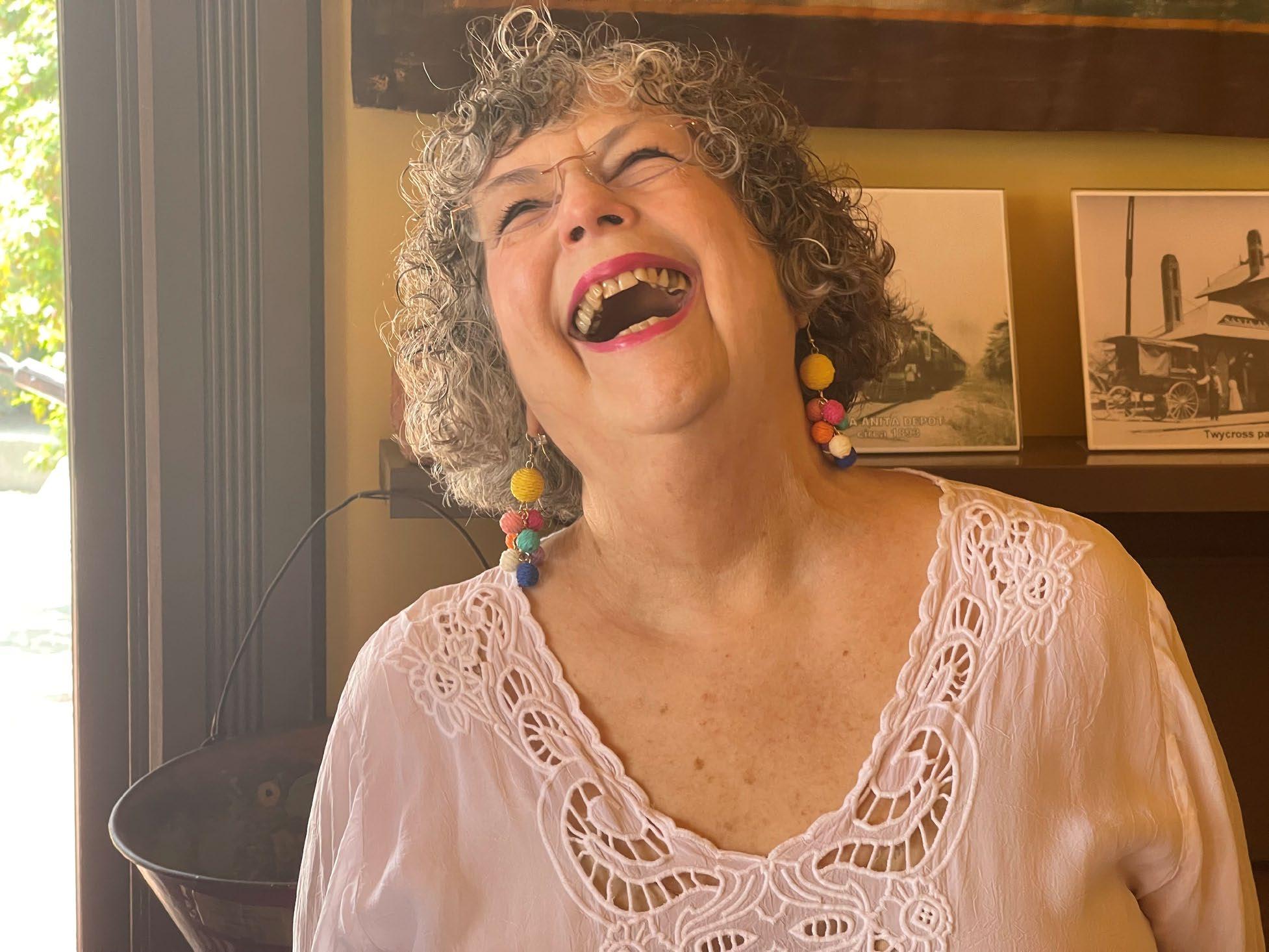
18 minute read
"IT'S NOT COMPLICATEDEATING HEALTHY, WHAT to EAT"
CHAPTER 3: WHAT to EAT Characteristics of good-quality food Learning to eat for today and for your future health.
"Focusing on staying healthy pays big dividends in both the quality and length of our lives as we age, and it is never too late to start." "You are the Medicine." Mark Hymen, Functional MD, Facebook post
"The nutrients within our food act as informa�on to our cells. When we give our bodies the right informa�on, they will func�on at their highest level of performance…we feel more energe�c, our minds are clearer, we look more vibrant…the list of benefits goes on and on." Dr. Mark Hyman, Func�onal MD
"Many people think it is expensive to eat healthier. Ea�ng healthy. In reality, costs less, and there is a reason for that. The way to look at it is what I will eliminate that is a waste of money as it not only provides no nutrients that will serve my body but causes consump�on of excess calories that deplete what my body needs. And if you are like the 50% of the popula�on who are obese, you are going to shed pounds while saving money. (Cheryl note: I lost 65 pounds this way by concentra�ng on ea�ng for my future health, not concentra�ng on losing weight.) You will be ea�ng less junk and less calories.
"There is no excuse for not cu�ng out Mountain Dew, Pepsi Cola, diet sodas, pop tarts and sugary cereals, frozen treats, cake, cookies, chips, fast food, and lots of white flour products. Adding whole foods is so much cheaper. You will need to do some cooking, adding beans, len�ls, sweet potato, vegetables, and fruits (organic if possible.) And por�ons can be smaller, and you don't need to snack 24/7. This is just basic common sense." Blanche Scharf, Func�onal Nutri�onist
Cheryl's comment: This doesn't mean I never eat a cookie or a cake, but I make my own to control that I only use quality ingredients. And they are only ever occasional treats. Also, I never drink pop; it is pure gut rot.
It shouldn't take studies to show how a whole food diet is healthier than a processed food diet. It is common sense to eat real food and to "Eat the Rainbow". This becomes a way of life where you eat every day to "feed" your future health and your future body. The mindset is different, and your body celebrates.
Calley Means 4/1/23, "So o�en, food or lifestyle interven�ons are put into a niche 'preventa�ve health' box - both in how policy is made and how we think. 'Serious' medical interven�ons occur a�er we are sick and diet-related advice is for nutri�onists and community groups. This view is factually wrong.
"Food is the most effective way to reverse (not just prevent) almost every chronic conditionfrom diabetes and heart disease (which should be obvious) to dementia and PCOS."

As a health coach, I always get ques�ons about "I have this symptom or that symptom. What should I do?"
The conclusion Calley Means comments on is also what I finally came to.
This is Blanch Scharf, Func�onal Nutri�onists comment:
"Restoring your entire body to health is the way to heal most health challenges. No matter what the health condition is, it needs the same basic improvements. The gut bacteria, the liver, the thyroid, adrenals, lymph system, pancreas, kidneys, and brain all need the same things no matter what the health condition. Inflammation must be addressed no matter what the problem is. Many times, when working with a group made up of diabetics, cancer patients, cardiovascular and autoimmune conditions, the script wasn't that different. Even when dealing with viral conditions, there were many similar recommendations. Healing means healing the whole body."
I always start with seeing if the person is willing to change their diet to a whole foods rainbow diet and an organic diet. I successfully run a Ditch the Diet and Stop Ea�ng CRAP course. An amazing thing happens when someone starts this course with me. At first, they called me every day from the grocer, with "Can I eat this?" or "Can I eat that?" I have them send me a picture of the label, and most likely, if they are asking, they already know that they should not eat it under the rules of engagement of the course. However, they are angry that they can't.


But by the end of the four-week course, they no�ce that their arthri�s isn't bothering them as much, they are no longer ge�ng con�nual headaches, their stomach isn't always upset anymore, or they just aren't feeling lousy all the �me. Once we get that far, holding the new ea�ng patern is easier because their body begins to support their efforts.
If they "fall off the wagon" the next �me I teach the course again, they can take it again for free. The pushback is different in round two, and the results are generally quicker. By the end, when they change their mindset about why they are ea�ng this way and what the wins are, it's much easier for them to maintain their new healthy ea�ng habits.
I s�ll get phone calls, but they are different. Now clients are calling to share how sensa�onal an organic cucumber tastes or how delicious the organic tomato they bought at the farmers market is. Their taste buds have shi�ed and are no longer dulled; as a result, real food starts to taste good. Now it's much harder to give up their new ea�ng lifestyle, and it is beginning to be a way of life.
"When a doctor or another healthcare provider names a condi�on you have, they are only looking at one piece of you. For true healing, you need to look at the whole, not a piece. That is why for many chronic condi�ons such as heart disease, liver problems, diabetes, autoimmune, and even cancer, the same rules work for each one of them. When you get treated for any of the condi�ons with pharmaceu�cals, chemo, or radia�on, it is a whole-body invasion. Even if you need to use one of these modali�es, you need to protect every system and organ from collateral damage. The way to do that is to focus on ge�ng everything stronger and working beter. You do this by feeding the mind, body, and spirit with what strengthens them. (Cheryl's comment: What strengthens them is ea�ng an organic, whole foods diet of the rainbow and the rest of the pillars of health.) I worked with many condi�ons and collaborated with func�onal doctors, energy healers, chiropractors, and Chinese herbalists, and it always came down to the same basics no mater what the condi�on." Blanche
Scharf, Func�onal Nutri�onist
So now that you know what kinds of food to avoid from Chapter Two, what should you look for to find nutritious, quality foods instead?
Eat real whole foods. Though in our current state of confusion, this is much easier said than done. So, try this: Don't eat anything your great-great-grandmother wouldn't recognize as food. i


1. Look for whole, real food and not food-like substances. The less processed it is, the better. And choose organic whenever possible. You do NOT need poison with every bite.
2. Eat the rainbow from a farm as close to you as possible, and eat as much organic as possible.
3. Cook at home: Cooking at home allows you to control the ingredients and portions in your meals, which can help promote healthier eating habits. Always use quality ingredients. Use organic as much as possible. Try to prepare meals that include a variety of nutrient-dense ingredients. Use quality omega-3 fats: avocado, coconut, ghee, pastured organic butter, and olive oil. Utilize olive oil that is extra virgin first press mostly for salads as it has a low burn point.
4. Every ingredient you eat should be something you recognize as real food. ii
5. "Eat less" is the most unwelcome advice of all, but the scien�fic case for ea�ng a lot less than we currently do is compelling. To make the "eat less" message a bit more palatable, consider that quality may have a bearing on quan�ty: I don't know about you, but the beter the quality of the food I eat, the less of it I need to feel sa�sfied." iii
Michael Pollen] Famous Chef and healthy food advocate.
Pay aten�on to por�on sizes: Ea�ng too much of any food can lead to weight gain and other health problems. Use por�on control strategies such as using smaller plates, measuring servings, and listening to your body's hunger and fullness cues. Stop ea�ng when you are 70% full and wait for your body to catch up with you. (Approx 20 minutes.)
Once you break the addiction to sugar and chemicals in processed food, your hunger hormones ghrelin and leptin are no longer dampened down. These hormones no�fy you when you are full, and you desire less food to be sa�sfied. As a result, you automa�cally begin to "eat less."
6. Eat quality protein
What qualifies as high-quality protein?
Whatever the protein source is, be it animal or vegetable, it needs to be high quality, and it needs to be real food.
• My mantra has become "Food Quality Maters." Animal protein needs to be from animals that eat their own specific diet. In other words, cows were designed to eat grass with two stomachs and must be finished on grass, not on GMO corn feed. I now understand what it means to be GMO, and I don't want those poisons in my or my client's bodies. iv
• Lambs eat grass naturally.

• Pigs will eat anything, but I learned that I felt best when the pork was heirloom and the pigs were pastured.
• Bison are designed to eat grasses.
• Chickens must also be pastured and evolved to eat grasses, berries, and bugs. And when they get their natural diet, they taste beter. And they are happier and less stressed, so their stress hormones are not in their meat or eggs.
• Eat wild fish. Wild fish eat natural food in streams, lakes, and oceans without chemicals, an�bio�cs, and hormones. (We do eat some farmed fish, but we also have found a fish monger whose family has been in the business for over 40 years, and she knows which fish farms are just roped off ocean and no hormones or chemicals are added to the fish's environment, and I trust her).
• All animal protein needs to be high quality and toxin-free, and the animals must be treated respec�ully. Otherwise, we are ea�ng their stress hormones, and trust me on this, we have plenty of our own. This is true whether we are discussing cows, pigs, or poultry. It's even true when we are discussing eggs.
• "The truth about meat is more nuanced than whether it is good or bad. While factoryfarmed red meat is an environmental and climate catastrophe, is inhumane, and may have adverse health consequences, this is not true of meat from regenera�vely raised animals. The real ques�on we should be asking is, is meat healthy or harmful?" Mark Hyman, Func�onal MD and author of 14 bestselling books, including "The Pegan Diet: 21 Prac�cal Principles for Reclaiming Your Health in a Nutri�onally Confusing World."
8. If the protein is vegetable, it also needs to be quality protein. It needs to be non-GMO. It needs to be organic if possible. And then there is some food combining that needs to happen so that complete amino acids fuel the body. So nuts, beans, soy, and seeds can all be excellent protein sources if they are high-quality, toxin-free, and combined correctly. And in the case of the new plant-based "meats," they can't be GMO or highly processed.
9. Eat animal protein as a condiment. Animal protein won't kill you, though it's beter approached as a side dish than as a main. I try to keep my animal protein to the size of the palm of my hand, with 70% of my plate being plant food. My husband feels beter when he eats more animal protein.
10. Drink ½ your body weight in filtered water. Stop drinking pop, both with sugar and ar�ficial sweeteners. They are both gut rot. Instead, only drink unsweetened fruit juice and pay aten�on to the amount of sugar per 8 ounces. I only drink cranberry, pomegranate, and unsweetened apple juice. The others can have as many as 12-20 teaspoons of sugar per 8 ounces.

11. Avoid high glycemic foods. White flour, processed flours. white sugar. Use almond flour instead of processed flours, and for sweeteners, I use monk fruit, stevia, or when I bake coconut sugar, maple syrup, or local honey, all of which have trace elements of goodness. Avoid agave. It is very difficult for the liver to process. Artificial sweeteners are chemicals that do harm to the body (and make you fat). The blue and pink packets are neurotoxins. The yellow packet kills good gut bacteria.
12. Buy and carry your own snack foods, and make them nutri�ous foods, like nuts, seeds, 70% organic chocolate, whole fruits like apples and pears, etc. I have a lengthy list of approved snack foods that I hand out in my Ditch the SAD class for my clients to use.
13. Avoid food products that come bearing health claims. They're apt to be heavily processed, and the claims are o�en dubious at best. v
14. Gravitate toward foods that are free from excessive chemicals and hormones. Read food labels; if there are ingredients you can't pronounce, it's probably not high-quality food. If you don't know what the ingredient is, again, it's probably not high-quality food, and most likely, It's fake food.
15. When purchasing organic foods, start with the EWG's Dirty Dozen list, which can help as a place to start. Remember: just because a food is labeled organic doesn't guarantee a healthy op�on. We are looking for real whole foods that your great great great grandmother would recognize as such.
16. Even if it is NOT on the Dirty Dozen list, it doesn't mean that it hasn't been sprayed with tons of herbicides or pes�cides. My next stop is "What's On My Food?" and it has convinced me to buy organic whenever possible. This is an example of the informa�on available on the What's On My Food Site https://whatsonmyfood.org/

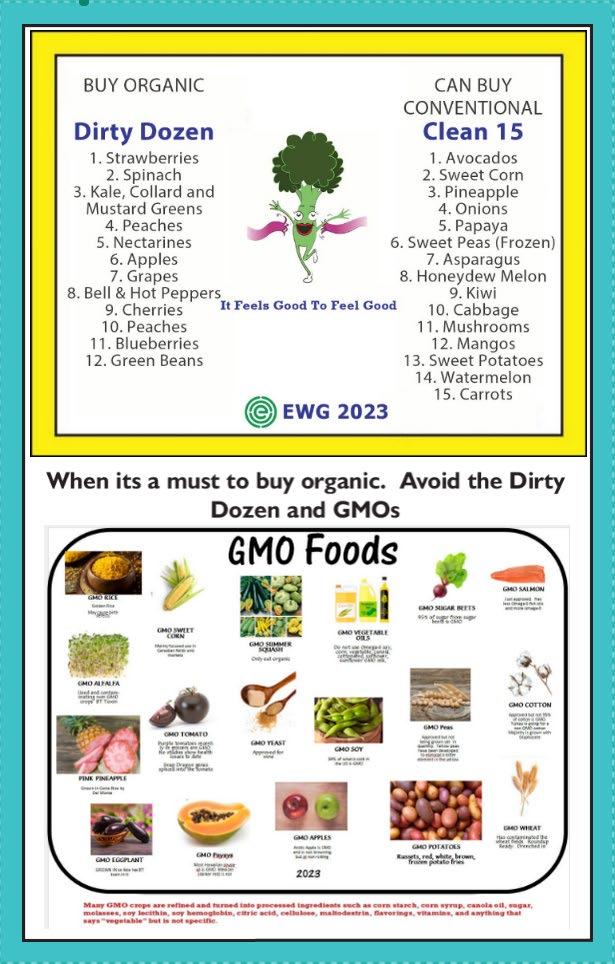
17. Avoid GMO foods- as discussed previously, they either have BT Toxin in them or are Roundup Ready, and either are laden with toxins (poison). (See charts for Dirty Dozen and GMO foods in Chapter 1)
18. Try to buy food in season. That's when the plant has the most nutrition for your body. vi Produce that is harvested in its proper season matures longer on the plant, which makes it more nutrient-dense when compared to being picked before its prime. It tastes better when harvested in season because it is picked at the peak of flavor. Buying seasonal produce can help the environment as it reduces water and land use, pollution, and soil degradation. vii Another new study shows that eating plant foods in season provides specific phytochemicals for our metabolic needs during that season. viii Also, since the food is abundant, the laws of supply and demand pertain, so it is also when the fruit or vegetable is at its best price. Eating plant foods in season provides specific phytochemicals for our metabolic needs during that season.

19. Diversity is important. Eat all the colors (even different colors of the same vegetable)
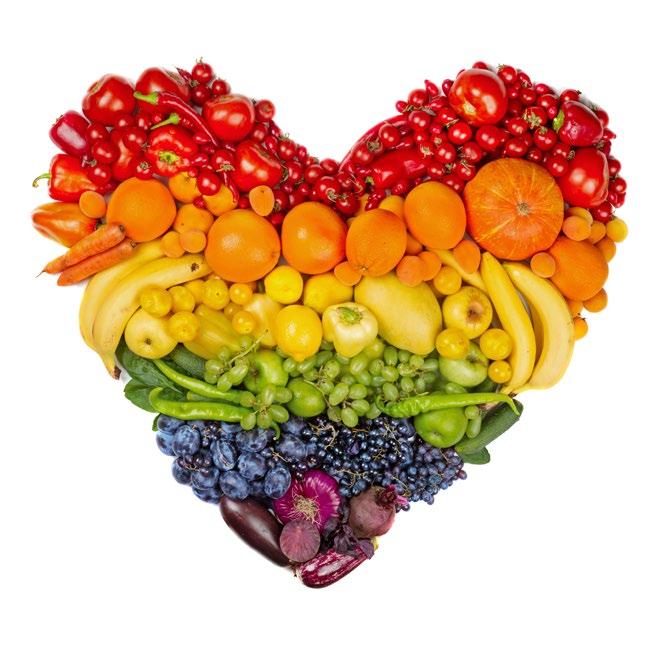
Eat each color in all the diversity you can find (red tomato, red radish, red bell pepper, etc.)
Eat from a farm as close to you as possible. The closer to harvest, the more and stronger the phytonutrients. (Eating from the Wild, Jo Robinson). Eat all the colors close together. Something magical happens in the body when all those phytonutrients come together and create health. Together they nourish every cell in your body, and the synergy of being together is the most effective they can be. Dr. Michael Gregor (How Not to Die) discusses the importance of diversity in a passage about cancer. Whereas one plant food shoots darts at breast cancer, another kills prostate cancer and does nothing against breast cancer. Radishes are completely unable to stop pancreatic cancer cell growth. However, they were 100% effective at halting the growth of stomach cancer cells. Orange bell peppers were useless against stomach cancer but were able to suppress prostate cancer cell growth by more than 75%.
In other words, eat a wide variety of all the plant foods. Try new vegetables and fruits. Phytonutrients are cutting-edge research; they are just learning about all the glorious gifts they offer the human body. After all, nature created them for the plant, and they just happen to have amazing gifts for us as well. So, by eating them in season, you offer your body the greatest gifts that plant foods offer
Stop eating processed dead grey food and seek out luscious colors in real, whole foods. Your body will thank you.
If you can't get them close to the farm, or buy a pepper in red, orange, and yellow, or buy it right when it is in season, it still has enormous gifts for your body. Buy and eat it anyway. Get the best you can where you are from the plant kingdom and feed your body health.
20. If possible, grow your own vegetables or fruit. You can start a pot garden, a backyard garden, or, if impossible, a tower garden. ix There is an initial investment in the tower system, but continual fresh food to pick can grow for months and years to come, so it amortizes itself quickly. Understand that tower gardens grow hydroponically, so you are missing essential nutrients from the earth. The closer you eat your produce to the harvest from the land, the more nutrients that plant food has for you.
21. You could join a community project and volunteer in the community garden. The produce is shared on a coop basis.
22. Buy local. Visit your local farmer's market, or shop at a local farm. Sign up for a weekly CSA box. Or join a COOP if you have one in your area. Not only will you be getting fresh, local, and minimally processed foods, but you'll be supporting your community at the same time. Again, it's important to eat as close to the harvest as possible.




23. Some services deliver freshly picked produce to your home. Check out your possibilities by Googling. I do have some others available to me in Los Angeles. If Misfits delivers to a state, they deliver anywhere in that state.

I also have a service called Farm Fresh to You and another service that I often use called Avocado.
Again, this list is not meant to be exhaustive or ironclad. But it can help you narrow down those foods that will benefit your health span, not shorten it.
24. The key is to buy real whole foods. I prefer clients to buy as much organic as possible. Still, if they cannot afford organic or if it is not available in their area for an item, it is important to buy as fresh as possible from available sources.
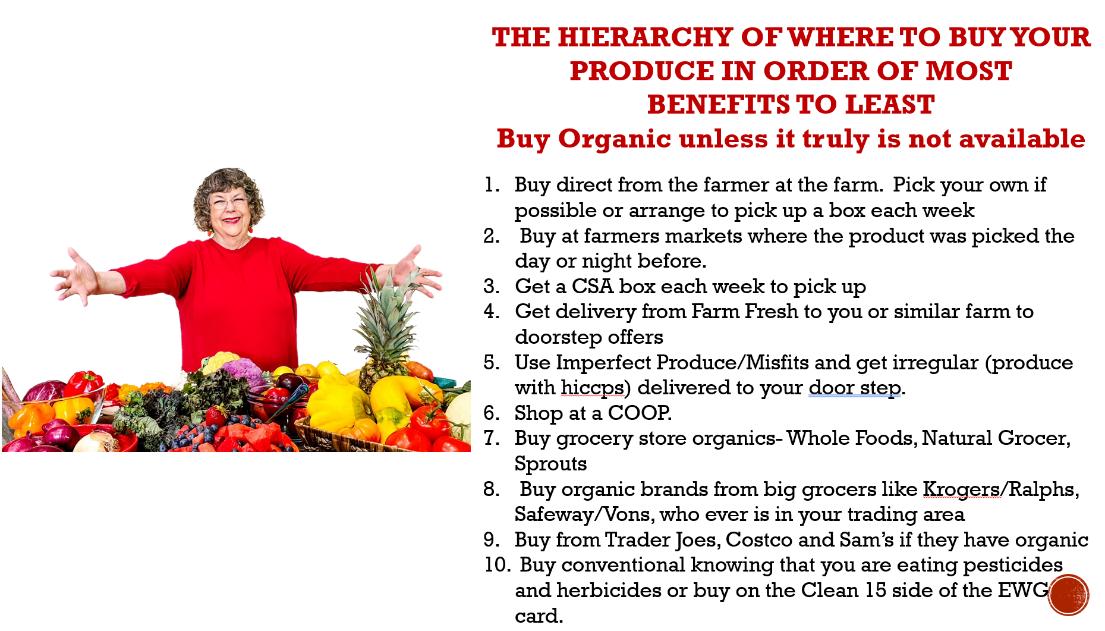
This Hierarchy chart is something I put together for my Food Quality Matters class to put buying whole foods into perspective. The key is to eat real food and choose the highest quality of real food you can afford.
25. If you are eating rice, it should be Lundberg rice because it is grown cleaner. Or it should be rice from California with less arsenic than rice grown in Texas or the South.
Follow this cooking method to get what arsenic remains in the rice:
26. Think of growing in your ability to recognize and consume quality, healthy foods as a gradual progression. Perfection is not the goal growth is. And instead of the mindset of eliminating all the "bad" foods you enjoy, understand that you can treat yourself to them occasionally and still be a healthy person. Have the mindset of eating nutrient-dense food for your future health.
Your body will reward you with "feeling great," so over time, you desire the diet in Chapter Two less and less. Over time it becomes non-negotiable to stay away from processed foods.

27. Eat lots of fiber- Processed foods have removed most of the fiber from the food, and fiber is very important to our health. The key is to eat over 40 grams of fiber per day. x
95% of Americans don't get enough fiber xi ."Fiber is essential for our metabolism, which processed foods often have removed. In fact, processing grains means removing the fiber shell.
• Studies show that elements in fiber help regulate our energy production through several mechanisms, including slowing glucose absorption and contributing to the microbiome's production of pro-metabolic chemicals.
• Fiber also slows inflammation by feeding gut bacteria. Fiber is often from prebiotic foods that feed our healthy gut bacteria. Fiber maintains the gut's mucus layer (a physical barrier that keeps pathogens out). Fiber is an important food source for the beneficial bacteria in our gut microbiome. Consuming a fiber diet can help promote a healthy gut microbiome, which can have numerous health benefits. Fiber is an essential part of a healthy diet.
• Fiber promotes digestive health: Fiber helps to promote healthy digestion by keeping our digestive system running smoothly. It helps to move food through our digestive tract, preventing constipation and other digestive problems.
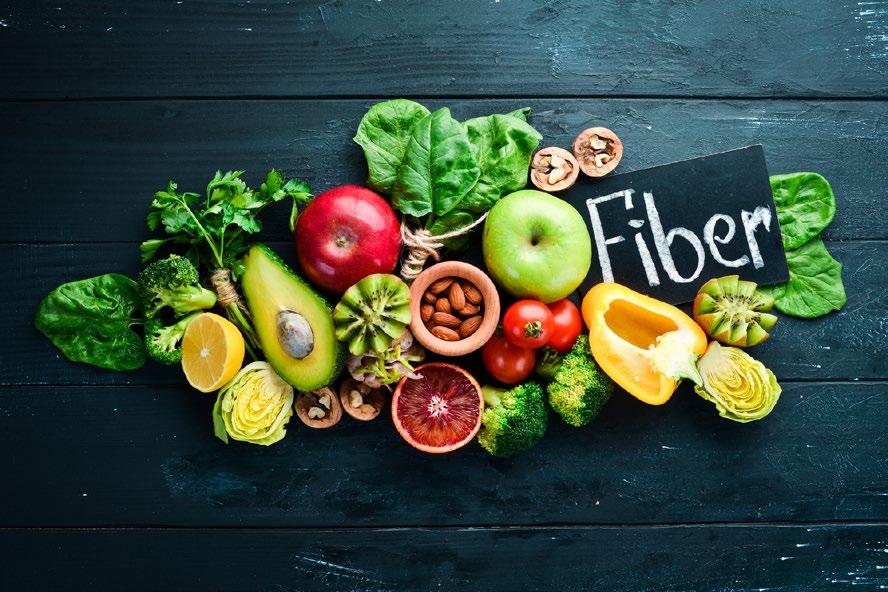
• Fiber helps control blood sugar levels: Fiber slows down the absorption of sugar in the bloodstream, which can help to prevent blood sugar spikes and dips. This can be particularly beneficial for people with diabetes or those at risk of developing diabetes.
• Fiber-heavy foods include chia seeds, flax seeds, nuts, avocados, certain beans, lentils, broccoli, cauliflower, apples and pears, whole fruits, potatoes, and mushrooms. Leafy greens and berries. Asparagus, artichokes, and acorn squash are all great fiber foods. Oats, barley, and quinoa. You get very little fiber, if any, from processed foods.
• Fiber promotes satiety: Foods that are high in fiber tend to be more filling, which can prevent overeating. This can be helpful for weight management and maintaining healthy body weight.
• Fiber reduces cholesterol levels: Soluble fiber, which is found in foods such as oats, beans, and fruits, has been shown to help lower cholesterol levels. This can benefit heart health and reduce the risk of heart disease.
• Fiber gives a ride to toxins from the liver out of the body through the colon. Therefore, it is a crucial component in removing toxins from the body.
• "Gut flora digest fiber and use it to make short-chain fatty acids, which have a number of health-promoting effects, such as inhibiting the growth of bad bacteria, increasing absorption of minerals (specifically, calcium), improving insulin sensitivity, and lowering colon cancer risk." xii
• This is brand new research on fiber, "Most of the healthy polyphenol phytonutrients in fruits and vegetables appear to be bound to the fiber and are only liberated for absorption by the friendly flora in your gut." xiii
• Overall, fiber is an important nutrient that is essential for our overall health and wellbeing. The recommended daily intake of fiber is around 40 grams per day for adults, but this can vary depending on age, gender, and other individual factors. Consuming a variety of high-fiber foods such as fruits, vegetables, whole grains, legumes, nuts, and seeds can help ensure that you get enough fiber in your diet. In addition, fiber can play an important role in supporting liver health. The liver is responsible for filtering toxins and waste products from the blood, and consuming a fiber diet can help support this process.
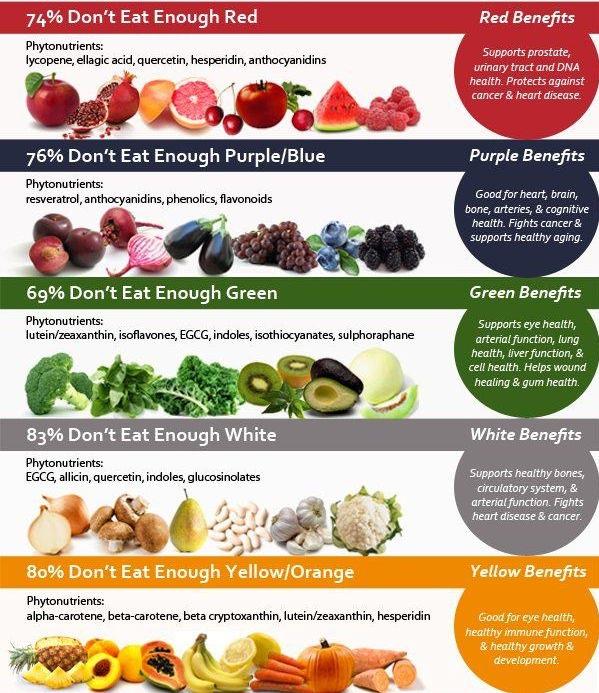
Now you can understand the additional danger of eating ultra-processed food as the central food in your diet. If it is fiber deficient, many important body processes cannot occur.
Food is far more than just calories or energy to fuel our bodies. It is information and instructions that regulate every function of our bodies in real time.
Food is not only a source of energy, joy, connection, and pleasure; it can also rejuvenate us and even reverse disease. When we think of food, we think of protein, carbohydrates, fats, fiber, vitamins, and minerals.
But the most important parts of food may be the tens of thousands of medicinal compounds embedded in plants and even animal foods that regulate, modulate, and influence nearly all the 37 billion chemical reactions that occur in our bodies every second. Our bodies use chemicals found in food to influence each of our biological systems beneficially.
We have borrowed the molecular magic embedded in foods through evolution to optimize and supercharge our biology. So, for example, we can't synthesize vitamin C or omega-3 fats; we must get these from nature. And it's not just the obvious essential fatty acids, amino acids, and vitamins and minerals we get from our food; we also get important molecules called phytochemicals. The phytochemicals are listed by the color family above. They are responsible for the term "eat from the farmacy" because these phytochemicals can heal the body from the inside out.
"There are 100,000-plus phytochemicals in the plant kingdom identified to date xiv, and they've only recently been deemed critical for health. Surprisingly they are also found in animals, such as grass-fed cows, who consume a wide array of nutrient-dense plant foods. While deficiency of these phytochemicals may not result in an acute disease like scurvy or rickets or protein malnutrition, it can lead to long-latency deficiency diseases such as heart disease, diabetes, hypertension, obesity, dementia, depression, and more. " Dr. Mark Hyman, Facebook Post.
The only way to take advantage of these disease-fighting compounds is to focus on our food quality. Deeply colorful plant foods, organic and grass-fed meats, and wild fatty fish are abundant in compounds that protect our cells and fight off invaders. So, every time you take a bite of food, consider that you are programming your biology for health or disease.
Eating healthy means consuming a balanced and varied diet that provides all the necessary nutrients for optimal health and wellbeing. It involves choosing foods that are high in nutrients and low in unhealthy fats, sugars, sodium, chemicals, and toxins
It Feels Good to Feel Good.
